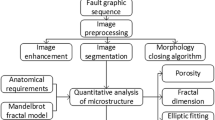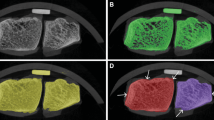Abstract
A well-defined three-dimensional (3-D) reconstruction of bone-cartilage transitional structures is crucial for the osteochondral restoration. This paper presents an accurate, computationally efficient and semi-automated algorithm for the alignment and segmentation of two-dimensional (2-D) serial to construct the 3-D model of bonecartilage transitional structures. Entire system includes the following five components: (1) image harvest, (2) image registration, (3) image segmentation, (4) 3-D reconstruction and visualization, and (5) evaluation. A computer program was developed in the environment of Matlab for the semi-automatic alignment and automatic segmentation of serial sections. Semi-automatic alignment algorithm based on the position’s cross-correlation of the anatomical characteristic feature points of two sequential sections. A method combining an automatic segmentation and an image threshold processing was applied to capture the regions and structures of interest. SEM micrograph and 3-D model reconstructed directly in digital microscope were used to evaluate the reliability and accuracy of this strategy. The morphology of 3-D model constructed by serial sections is consistent with the results of SEM micrograph and 3-D model of digital microscope.
Similar content being viewed by others
References
H Madry, CN van Dijk, M Mueller-Gerbl, The basic science of the subchondral bone. Knee Surg Sports Traumatol Arthrosc, 18, 419 (2010).
N Ugryumova, DP Attenburrow, CP Winlove, et al., The collagen structure of equine articular cartilage, characterized using polarization-sensitive optical coherence tomography. J Phys D: Appl Phys, 38, 2612 (2005).
CE Kawcak, CW McIlwraith, RW Norrdin, et al., The role of subchondral bone in joint disease: a review. Equine Vet J, 33, 120 (2001).
F Wang, Z Ying, X Duan, et al., Histomorphometric analysis of adult articular calcified cartilage zone, J Struc Biol, 168, 359 (2009).
K Allan, R Pilliar, J Wang, et al., Formation of biphasic constructs containing cartilage with a calcified zone interface, Tissue Eng, 13, 167 (2007).
B Daubs, M Markel, P. Manley, Histomorphometric analysis of articular cartilage, zone of calcified cartilage, and subchondral bone plate in femoral heads from clinically normal dogs and dogs with moderate or severe osteoarthritis, Am J Vet Res, 67, 1719 (2006).
H Gupta, S Schratter, W Tesch, et al., Two different correlations between nanoindentation modulus and mineral content in the bone-cartilage interface, J Struct Biol, 149, 138 (2005).
T Lyons, S McClure, R Stoddart, et al., The normal human chondro-osseous junctional region: evidence for contact of uncalcified cartilage with subchondral bone and marrow spaces, BMC Musculoskelet Disord, 7, 52 (2006).
P Buma, JS Pieper, T van Tienen, et al., Cross-linked type I and type II collagenous matrices for the repair of fullthickness articular cartilage defects—a study in rabbits, Biomaterials, 24, 3255 (2003).
H Domaschke, M Gelinsky, B Burmeister, et al., In vitro ossification and remodeling of mineralized collagen I scaffolds, Tissue Eng, 12, 949 (2006).
M Gelinsky, M Eckert, F Despang, Biphasic, but monolithic scaffolds for the therapy of osteochondral defects, Int J Mat Res (formerly Z. Metallkd.), 98, 749 (2007).
M Gelinsky, P Welzel, P Simon, et al., Porous three-dimensional scaffolds made of mineralised collagen: Preparation and properties of a biomimetic nanocomposite material for tissue engineering of bone, Chem Eng J, 137, 84 (2008).
I Martin, S Miot, A Barbero, et al., Osteochondral tissue engineering, J Biomech, 40, 750 (2007).
J Sherwood, S Riley, R Palazzolo, et al., A three-dimensional osteochondral composite scaffold for articular cartilage repair, Biomaterials, 23, 4739 (2002).
A Yokoyama, M Gelinsky, T Kawasaki, et al., Biomimetic porous scaffolds with high elasticity made from mineralized collagen-An animal study, J Biomed Mater Res Part B: Applied Biomaterials, 75, 464 (2005).
J Donohue, D Buss, T Oegema, et al., The effects of indirect blunt trauma on adult canine articular cartilage, J Bone Joint Surg, 65, 948 (1983).
Y Lu, T Jiang, Y Zang, Region growing method for the analysis of functional MRI data. Neuroimage, 20, 455 (2003).
W Li, J Tian, E Li, et al., Robust unsupervised segmentation of infarct lesion from diffusion tensor MR images using multiscale statistical classification and partial volume voxel reclassification. Neuroimage, 23, 1507 (2004).
E Sharon, A Brandt, R Basri, Segmentation and boundary detection using multiscale intensity measurements. Comput Vis Pattern Recogn, 1, 469 (2001).
N E A Khalid, N M Ariff, S Yahya, et al., A Review of Bioinspired Algorithms as Image Processing Techniques. Communin Comput Inf Sci, 179, 660(2011).
T Scarabino, GM Giannatempo, T Popolizio, et al., 3.0-T functional brain imaging: a 5-year experience. Radiol Med, 112, 97(2007).
FS Sjostrand, Ultrastructure of retinal rod synapses of the guinea pig eye as revealed by three-dimensional reconstructions from serial sections, J Ultrast Res, 2, 122 (1958).
E Glaser, H Vanderloos, A semi-automatic computer-microscope for the annalysis of neuronal morphology, IEEE Trans Biomed Eng, 12, 22 (1965).
C Bron, P Gremillet, D Launay, et al., Three-dimensional electron microscopy of entire cells, J Microsc, 157, 115 (1990).
P Gremillet, M Jourlin, C Bron, et al., Dedicated image analysis techniques for three-dimensional reconstruction from serial sections in electron microscopy, Mach Vision Appl, 4, 263 (1991).
C Schmolke, Tissue compartments in laminae II-V of rabbit visual cortex—three-dimensional arrangement, size and developmental changes, Anat Embryol, 193, 15 (1996).
C Schmolke, K Fleischhauer, Morphological characteristics of neocortical laminae when studied in tangential semithin sections through the visual cortex of the rabbit, Anat Embryol, 169, 125 (1984).
T Schormann, K Zilles, Three-dimensional linear and nonlinear transformations: an integration of light microscopical and MRI data, Hum Brain Mapp, 6, 339 (1998).
S Ourselin, A Roche, G Subsol, et al., Reconstructing a 3D structure from serial histological sections, Image Vision Comput, 19, 25 (2001).
M Viergever, J Maintz, W Niessen, et al., Registration, segmentation, and visualization of multimodal brain images, Comput Med Imag Grap, 25, 147 (2001).
A Hess, K Lohmann, E Gundelfinger, et al., A new method for reliable and efficient reconstruction of 3-dimensional images from autoradiographs of brain sections, J Neurosci Methods, 84, 77 (1998).
J Dauguet, T Delzescaux, F Conde, et al., Three-dimensional reconstruction of stained histological slices and 3D non-linear registration with in-vivo MRI for whole baboon brain, J Neurosci Methods, 164, 191 (2007).
O Schmitt, J Modersitzki, S Heldmann, et al., Image registration of sectioned brains, Int J Comput Vision, 73, 5 (2007).
I Sigala, J Flanaganc, I Tertineggc, et al., Reconstruction of human optic nerve heads for finite element modeling, Technol Health Care, 13, 313 (2005).
M Belohlavek, DA Foley, TC Gerber, et al., Three-dimensional reconstruction of color Doppler jets in the human heart, J Am Soc Echocardiogr, 7, 553 (1994).
J Stevens, J Trogadis, Computer-assisted reconstruction from serial electron micrographs: a tool for the systematic study of neuronal form and function, Advan Cell Neurobiol, 5, 341 (1984).
L Brown, A survey of image registration techniques, ACM Comput Surv (CSUR), 24, 325 (1992).
A Toga, P Banerjee, Registration revisited, J Neurosci Methods, 48, 1 (1993).
B Zitova, J Flusser, Image registration methods: a survey, Image Vision Comput, 21, 977 (2003).
G Penney, J Weese, J Little, et al., A comparison of similarity measures for use in 2D-3D medical image registration, Med Image Comput Comput-Assisted Int, 1496, 1153 (1998).
A Roche, G Malandain, N Ayache, Unifying maximum likelihood approaches in medical image registration, Int J Imag Syst Tech, 11, 71 (2000).
J Humm, R Macklis, X Lu, et al., The spatial accuracy of cellular dose estimates obtained from 3D reconstructed serial tissue autoradiographs, Phys Med Biol, 40, 163 (1995).
C Papadimitriou, C Yapijakis, P Davaki, Use of truncated pyramid representation methodology in three-dimensional reconstruction: an example, J Microsc, 214, 70 (2004).
S Brandt, J Heikkonen, P Engelhardt, Multiphase method for automatic alignment of transmission electron microscope images using markers, J Struct Biol, 133, 10 (2001).
Author information
Authors and Affiliations
Corresponding author
Rights and permissions
About this article
Cite this article
Guo, H., Xu, ZW., He, BR. et al. Three dimensional reconstruction of bone-cartilage transitional structures based on semi-automatic registration and automatic segmentation of serial sections. Tissue Eng Regen Med 11, 387–396 (2014). https://doi.org/10.1007/s13770-014-0027-6
Received:
Revised:
Accepted:
Published:
Issue Date:
DOI: https://doi.org/10.1007/s13770-014-0027-6




